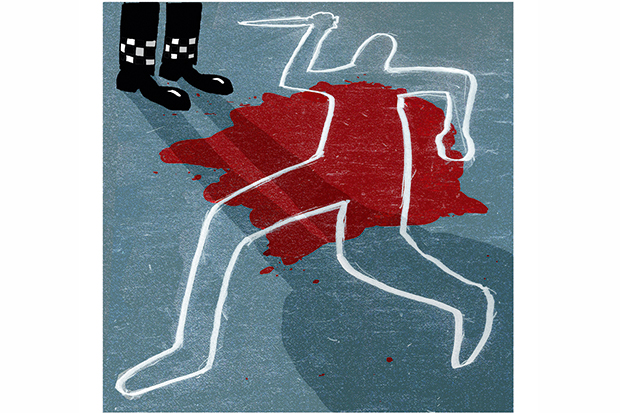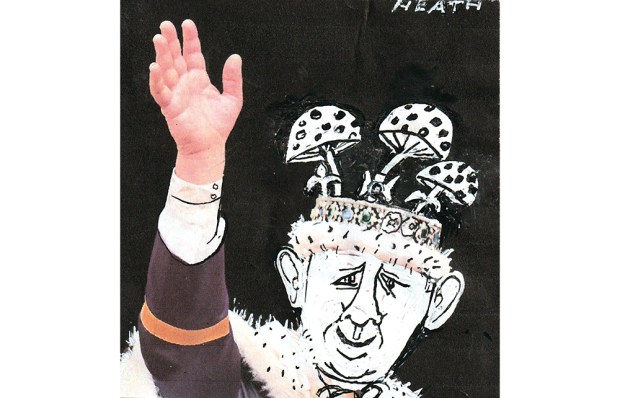Pity the poor crime writers. Our earnings, like those of all authors, are diminishing for reasons far beyond our control. Our fictional criminals and detectives are being outsmarted by genetic fingerprinting, omnipresent security cameras and telltale mobile phones. Who needs Sherlock Holmes to solve a tricky crime when you have computers, with their unsporting ability to transmit and analyse enormous quantities of data and identify culprits? But the bigger problem for us novelists (if not for everyone else) is that murder itself is dying.
The official homicide rate peaked in 2002, thanks to Dr Harold Shipman, and has since fallen by half — from 944 then to 517 last year. Adjusting for population, murder is now at the same level it was in the last years of Queen Victoria — and, in spite of what Arthur Conan Doyle led readers to believe, the streets were pretty safe then. The murder rate started to rise in the 1960s and soared in the 1990s, which caused widespread panic. Family breakdown, collapsing morals and a feral underclass were all blamed for an apparently inexorable increase in violent crime.
But then that rise stopped, and the murder rate began to nosedive. Why? Or, as we crime writers say, whodunnit?
Investigating the murder of murder is difficult, especially when statistics derive from a variety of sources. This is not just a British phenomenon. Homicide rates throughout the industrialised world have declined during the past century. The fall in Britain, the USA and Canada is particularly marked — these are all countries where the rate increased in the 1960s and 1970s. And it isn’t just murder. Over the past 20 years robbery has declined almost as much as homicide, and vehicle theft more so.
Prosperity is often fingered as the prime suspect, the idea being that the economic boom of the 1990s suppressed many of the conditions in which crime flourishes. It’s a nice theory, but unfortunately it doesn’t hold up to scrutiny. You can search in vain for any correlation between national wealth and crime figures. During the Great Depression, when unemployment rose to 25 per cent, the crime rate in many cities went down. When Britain became far richer in the 1960s, crime started to spike. But since the beginning of the economic crash, in 2008, murder rates have continued their downward trend.
Evidence from the rest of the world further undermines the idea that wealth is killing homicide. In its 2011 Global Study on Homicide, the United Nations Office on Drugs and Crime confirmed that the murder rate had fallen worldwide during the recession.
Which leads us to another possibility: perhaps the murder rate has fallen because we have put most potential murderers behind bars for other crimes? Britain’s prison population has doubled over the past 25 years, and almost doubled in Australia and the United States. Alas, this theory is fatally undermined by conflicting statistics from other developed countries, such as Canada and the Netherlands, where they’ve released plenty of prisoners without any corresponding surge in homicides. Even in New York, once a hotbed of murder, imprisonment has fallen by 26 per cent over the last decade — and crime has fallen by 28 per cent.
So we must search for another lead. Perhaps the police are getting better at preventing crimes? If this is true, the police must have brought about the reduction in violent crime with fewer officers: last year, Britain had 154,000 boys and girls in blue, some 10 per cent less than when David Cameron came to power. For the Police Federation, who were arguing against the cuts, it’s all rather embarrassing: their budget was slashed and surveyed crime is now at its lowest since records began 25 years ago.
The increase in ‘data-driven’, ‘CompStat’ or ‘hotspot’ policing has no doubt helped prevent a lot of crime. This involves the flexible use of police resources, allowing forces to respond rapidly to potential trouble spots by flooding them with officers. Another tactic is the so-called ‘broken windows’ approach, whereby police crack down rigorously on low-level offences in the hope of preventing more serious ones in the long run. A third method involves building trust through community–oriented policing.
But is any of that really the difference between a rising crime rate and a falling one? The evidence from America is mixed. One study looked at three cities that each pursued a very different approach to policing. In New York, the police force quadrupled in size and there was what is politely called an ‘oppositional’ relationship between neighbourhoods and officers. In San Diego, the number of police on the beat remained much the same as before. In Washington DC, the police chief pursued an ‘empathy’ policy, reducing the level of confrontation between police and public. Three cities, three policies, and in each case the result was a swift drop in crime.
Some experts argue that the decline is due to wider demographic changes. Western societies have more old people now, and the elderly are much less likely than younger people to commit violent crime — or to be victims of it. The original baby boomers are collecting their pensions, and the second generation of baby boomers are now in their forties. But in London this answer doesn’t stand up to close scrutiny either. The number of 18-to-24-year-old men — the group most likely to turn to crime — has increased, while London’s crime rate, apart from a small spike in murder last year, has continued to drop.
So perhaps it’s just that the usual suspects — young people — are better behaved than their parents were? They are more likely to be university-educated and, across the EU as a whole, a quarter of them aged 27 to 34 are still living with their parents. They are less likely to drink or consume illegal drugs than their parents at the same age. Sober young people tend not to kill.
Some think that the real clue lies in the womb. In 2001, an American economist named Steven D. Levitt argued that legalising abortion may have had the unexpected side-effect of lowering the crime rate. This controversial theory is based on two premises: that unwanted children are more likely to turn to crime; and that legalising abortion means fewer unwanted births.
A number of American and Canadian studies have established the possibility of a link between legalised abortion and diminishing rates of homicide. If they’re right, Levitt claims, this would account for 25 to 30 per cent of ‘the observed crime decline in the 1990s’. Correlation, however, does not amount to causation and the theory does not appear to work outside North America. The tapering off of criminal activity has also continued long after abortion rates stabilised.
And so we turn to identifying the murder weapon. Countries with strict gun laws have few homicides. Among OECD countries, America’s murder rate is second only to Mexico’s, though the number of violent assaults is comparable to other western countries. Guns are used in two thirds of all murders. Since Obama has been in the White House, however, gun sales have actually risen. In 2013 alone, Americans bought about 16 million new firearms. Yet the rate at which they gunned down their fellow Americans has halved over the past two decades.
Of course, it is worth looking at the lifestyle of potential perpetrators. The street price of heroin has plunged in recent years (it’s now about £10 a hit), which has led to suggestions that a fall in violent crime is at least partly due to the fact it is now easier for addicts to fund their habit without crime. Similarly, the crack epidemic’s decline has been cited as a contributing factor.
No theory, however unlikely-sounding, should be dismissed without thorough investigation. And so it might be that the phased removal of lead from petrol and paint caused a drop in violent crime. Lead pollution has a well-documented effect on children’s brains, leading to aggressive behaviour and cognitive delays. Some researchers have matched the rise and fall of such pollution to the rise and fall of murder, though oddly enough they have found no link between it and property crime. Nevertheless Jessica Reyes, an American economist, credits cleaner air with 56 per cent of the reduction in violent crime. Many other experts find the theory suspiciously simplistic and less than plausible, so in the absence of supporting evidence it’s not convincing. The increased use of mood-enhancing drugs such as Prozac and Ritalin has also been suggested as a factor.
If this were a murder mystery, it would be the unsatisfactory sort that has too many far-fetched suspects. The solution in one of Agatha Christie’s better-known stories turned out to be that all the suspects were guilty of the murder. Perhaps that’s happened here. But we really don’t know. The creator of Hercule Poirot would have arranged things much better.
Got something to add? Join the discussion and comment below.
Get 10 issues for just $10
Subscribe to The Spectator Australia today for the next 10 magazine issues, plus full online access, for just $10.
Andrew Taylor’s latest novel is The Ashes of London. Andrew Taylor is a winner of the Cartier Diamond Dagger for lifelong excellence in crime fiction, and a regular crime reviewer for The Spectator.
You might disagree with half of it, but you’ll enjoy reading all of it. Try your first month for free, then just $2 a week for the remainder of your first year.














Comments
Don't miss out
Join the conversation with other Spectator Australia readers. Subscribe to leave a comment.
SUBSCRIBEAlready a subscriber? Log in